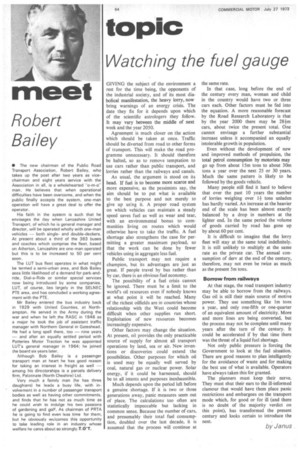topic
Page 66

If you've noticed an error in this article please click here to report it so we can fix it.
Watching the fuel gauge
GIVING the subject of the environment a rest for the time being, the opponents of the industrial society, and of its most diabolical manifestation, the heavy lorry, now bring warnings of an energy crisis. The date they fix for it depends upon which of the scientific astrologers they follow. It may vary between the middle of next week and the year 2050.
Agreement is much closer on the action which should be taken at once. Traffic should be diverted from road to other forms of transport. This will make the road programme unnecessary. It should therefore be halted, so as to remove temptation to use cars rather than public transport, and lorries rather than the railways and canals.
As usual, the argument is stood on its head. If fuel is to become more scarce and more expensive, as the pessimists say, the aim should be to put what is available to the best purpose and not merely to give up using it. A proper road system on which• vehicles can maintain a steady speed saves fuel as well as wear and tear, with an environmental bonus to communities living on routes which would otherwise have to take the traffic. A fuel shortage also strengthens the case for permitting a greater maximum payload, so that the work can be done by fewer vehicles using in aggregate less fuel.
Public transport may not require a champion, but its advantages are just as great. If people travel by bus rather than by car, there is an obvious fuel economy.
The possibility of a fuel crisis cannot be ignored. There must be a limit to the world's oil resources even if nobody knows at what point it will be reached. Many of the richest oilfields are in countries whose relationship with the West could become difficult when other supplies run short. Exploitation of new resources becomes increasingly expensive. Other factors may change the situation. At present, oil provides the only practicable source of supply for almost all transport operations by land, sea or air. New inventions or discoveries could extend the possibilities. Other purposes for which oil is used may be equally well served by coal, natural gas or nuclear power. Solar energy, if it could be harnessed, should be to all intents and purposes inexhaustible.
Much depends upon the period left before a genuine shortage. If it is two or three generations away, panic measures seem out of place. The calculations too often are statistically impeccable but lacking in common sense. Because the number of cars, and presumably their total fuel consumption, doubled over the last decade, it is assumed that the process will continue at the same rate.
In that case, long before the end of the century every man, woman and child in the country would have two or three cars each. Other factors must be fed into the equation. A more reasonable forecast by the Road Research Laboratory is that by the year 2000 there may be 28+m cars, about twice the present total. One cannot envisage a further substantial increase unless it accompanied an equally intolerable growth in population.
Even without the development of new and improved methods of propulsion, the total petrol consumption by motorists may go up from about 15m tons to about 30m tons a year over the next 25 or 30 years. Much the same pattern is likely to be followed by the goods vehicle.
Many people still find it hard to believe that over the past 10 years the number of lorries weighing over 1+ tons unladen has hardly varied. An increase at the heavier end of the scale has been almost exactly balanced by a drop in numbers at the lighter end. In the same period the volume of goods carried by road has gone up by about 60 per cent.
It is difficult to imagine that the lorry fleet will stay at the same total indefinitely. It is still unlikely to multiply at the same rate as the private car. The annual consumption of dery at the end of the century, therefore, may not even be twice as much as the present 5m tons.
Borrow from railways
At that stage, the road transport industry may be able to borrow from the railways. Gas oil is still their main source of motive power. They use something like lrn tons a year, and only one-fifth or one-quarter of an equivalent amount of electricity. More and more lines are being converted, but the process may not be complete until many years after the turn of the century. It could be accelerated if by that time there was the threat of a liquid fuel shortage.
Not only public pressure is forcing the Government to look at the fuel situation. There are good reasons to plan intelligently for the avoidance of waste and for making the best use of what is available. Operators have always taken this for granted.
The planners must keep their nerve. They must shut their ears to the ill-informed clamour that would have them place panic restrictions and embargoes on the transport mode which, for good or for ill (and there is no doubt of the majority verdict on this point), has transformed the present century and looks certain to introduce the next.
























































































































































